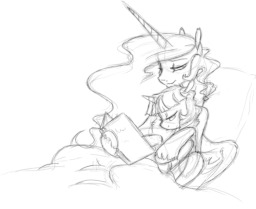
Dinosaur - Knight of Cerebus - Feb. 15, 2015
“Long ago these mighty creatures roamed the earth. For seven million years they were the most successful animals on the surface of the planet. Then, suddenly, a change in climate wiped out all of them. We believe it was volcanism, which then led to the acidification of the oceans and the loss of vegetation across the surface of the planet.”
A bright-eyed little student watched her teacher in awe, taking notes as quickly as her little forearms could manage. The teacher turned from the rest of the class to give her a quiet smile, then turned to look at the bones assembled before her. There were large, spike-backed reptiles with brilliant protruding wings and fiercely curved claws. Some sort of bird with back legs more at place on a cat was suspended mid-flight from the cieling. “Can you imagine it? Vast herds of them, lost to time and space itself. We think that these features on their heads--yes, the horns there--were used mostly for display. At this point in time it was very common amongst the animals alive in the period to have six legs, two made for flight, it is also known that there were vestigal creatures--such as this one.” The teacher paused, her attention turning to a skeleton with a massive, heavy skull and dozens of flattened teeth with blunt cusps on the end. Eye sockets larger than the students’ own heads stared back at them lifessly.
“This one we know lived in some sort of forested area. Some of the pollen from the deposit we found it in comes from plants still found there to this day. Apples, wheat, oats, grasses, oak and elm trees are all known to have grown in the area. You can see the powerful back legs,” she gestured with one arm to the animal’s thick limbs, which terminated in a single toe made of a powerful platform of calcium and keratin, “here. It’s a matter of debate as to what they were used for. Some believe that the reinforced back legs were used so the creature--which we call Ineptahippus verus--could prop itself up on only two legs and reach the apples found in the area surrounding. Others suspect they were a defense against predators, and still others think it may have used them to kick down trees in order to reach its food. Until we find more evidence, we may never know for sure.”
The students were mostly too busy staring at the strange giants before them to internalize any of what was being said. That lost world that had been brought to them in fragments was not of interest to most of them. Instead, only its most immediate fruits drew their focus. But not the bright-eyed little creature near the front of the class. As ever, the immensity of the world around her fascinated her, and it seemed to be getting ever bigger as time passed by. She stopped by a pair that especially fascinated her, hoping she might draw the eye of her teacher.
The skeleton of two giants were curled around one another, forelimbs interlocking. Their thin, long arms ended not in claws but in more of the blunted toes. The two skulls were touching, and one appeared to have caved in partially under the weight of the other. The necks were bent, for the giants were of unequal size. One was only half the height of the other, and yet they still dwarfed the little feather animal in front of them. She searched her notes for what they might be, but nowhere did it state that there was such a species presented. “Miss Butire? What about these ones?” She pointed a scaly talon at the two creatures before them, the enormity of the five-pronged bones sprouting from their back suddenly drawing her focus. “Do we know anything about these two?”
“We do, in fact. They are the most recent animals from the Equizoic we have in our collection, actually. That means they lived the closest to our time period. We think they’re a unique species, and we call them Alicornus regalis, which means “royal pure horn”. Their horns were known to be much longer than those of any other species around them, and we think that their large size and spectacular horns and wings were part of the sign that their species was dying. When animals are about to go extinct, you see, they usually get bigger as an attempt to survive. A kind of last hurrah, really.”
“Do we know why they died holding each other?”
“We don’t really know why, actually. We know that there were social animals amongst these creatures, but a lot of theories have been put forward. The most popular one is that they died fighting each other, possibly over territory and food. That is the only reason why animals so different from one another would be buried together in the modern day, after all. But the modern day only shows us so much.” The two hollow, lifeless figures stared out at the assembled classroom, daring them to try to understand the lives they had lead so very many years ago. “Whatever kind of life the two of them lead, it’s almost all lost to us now.”
The students stared for a while at the strange-looking creatures on display, as if they were in a freakshow of the lost worlds of yesteryear. Then, at last, once the teacher noticed that the freaks of the old world had started to bore them, she shepherded them away from the ancient animals. Her littlest and brightest student stayed a moment, though, staring into the eyes of those creatures so long removed from their ancient world and lives, so much forgotten and neglected by those living just the same on their world today. At last the little student broke away to join the class, and the two giant alicorns returned to their world of half-remembered secrets.
